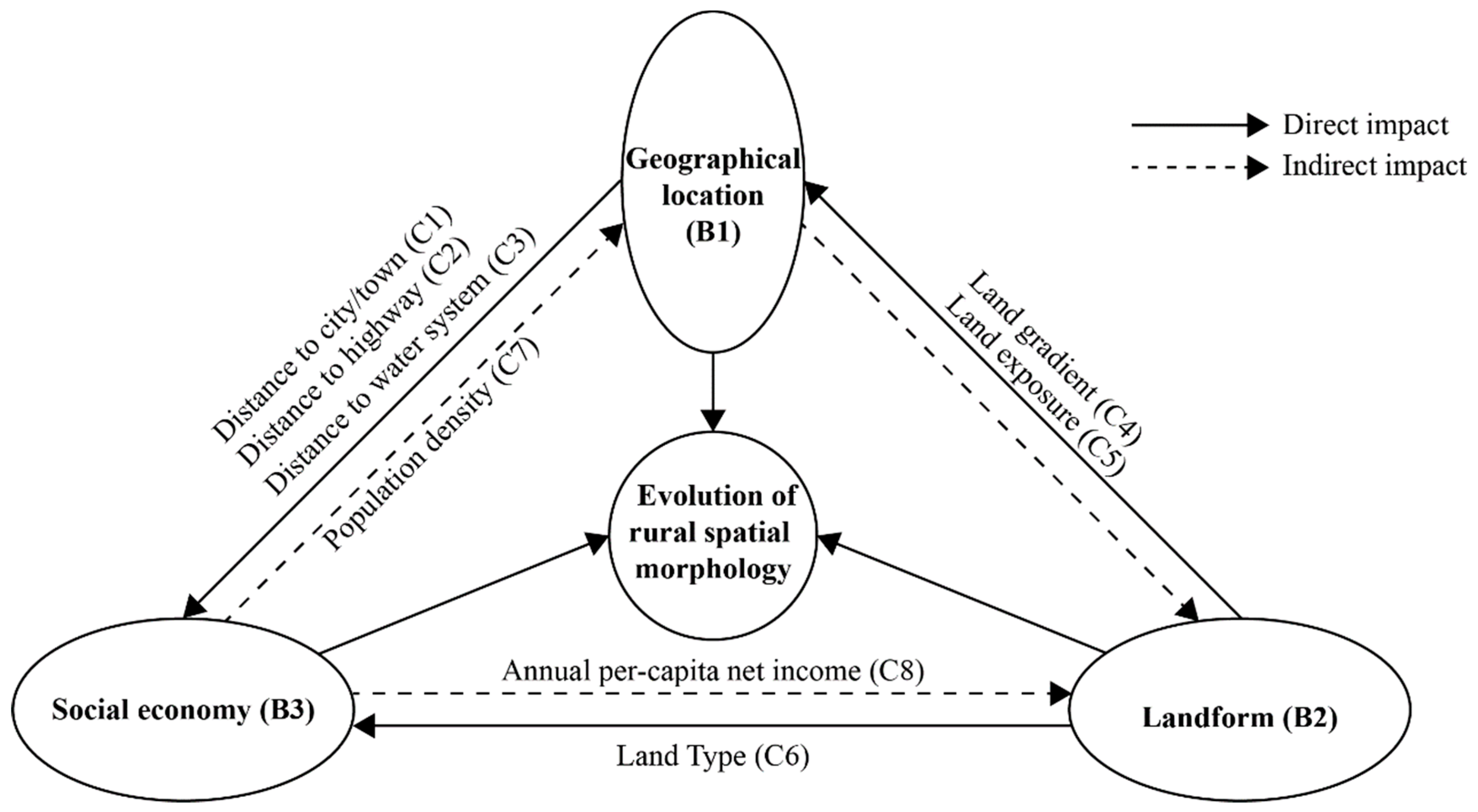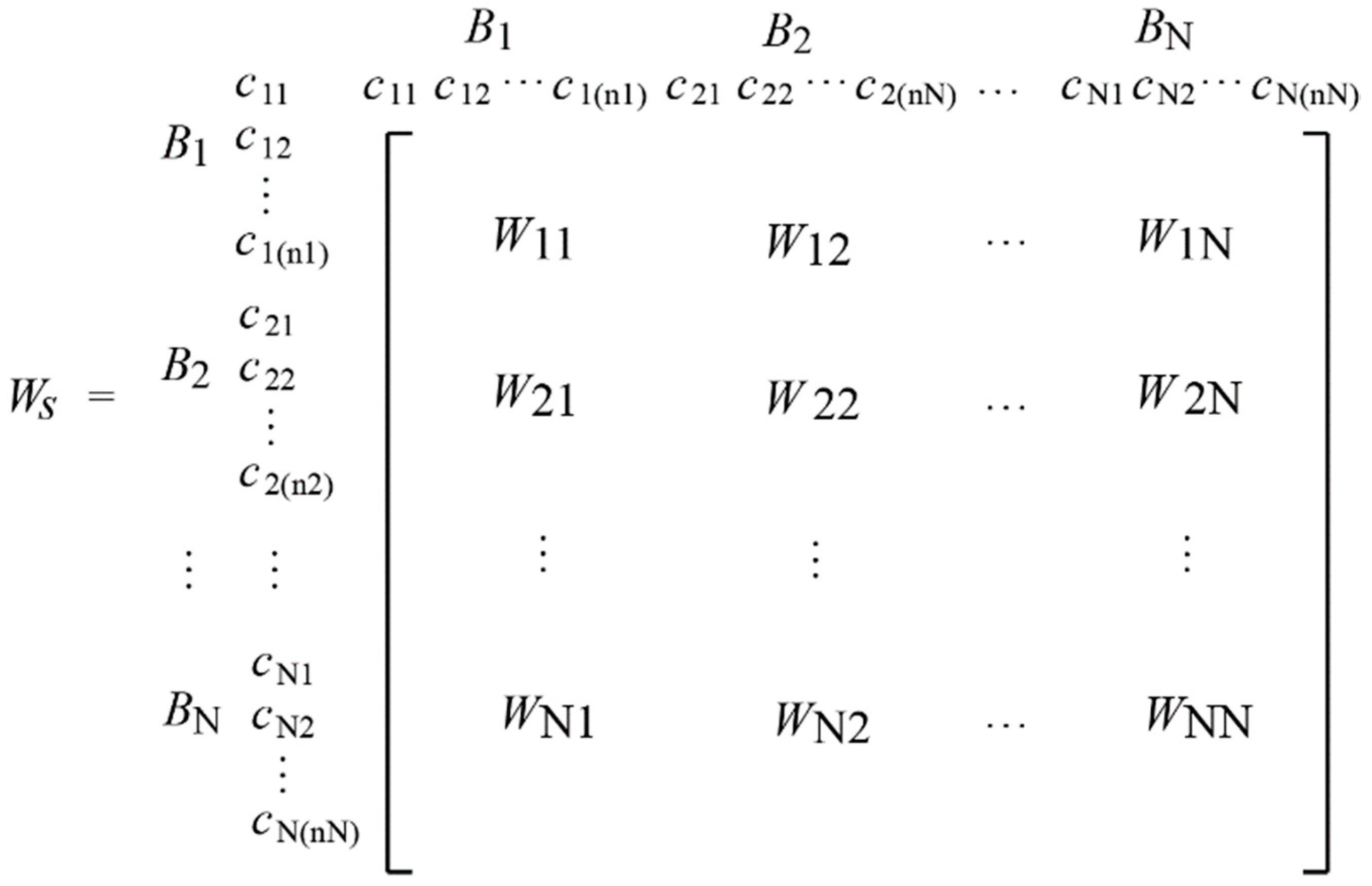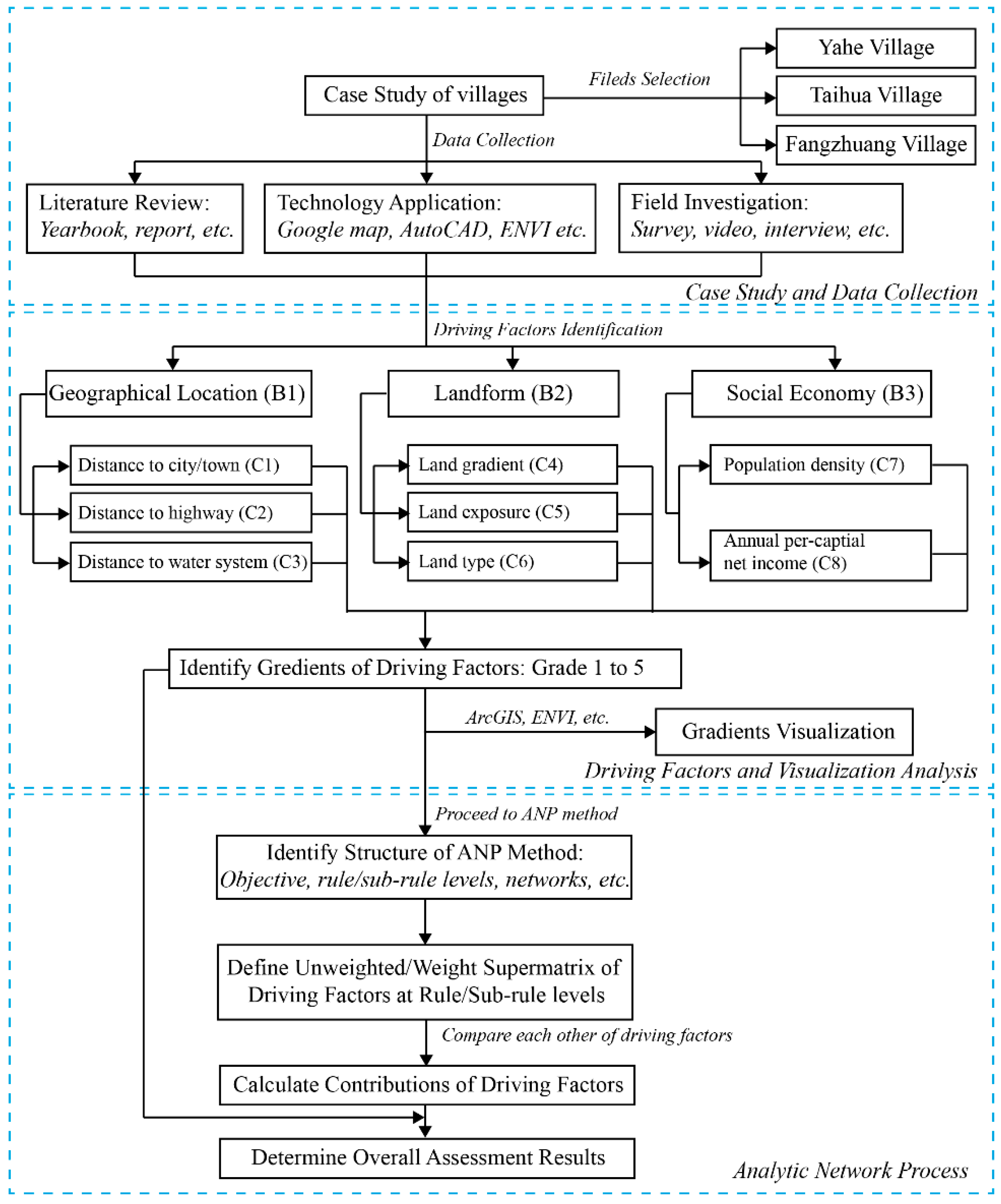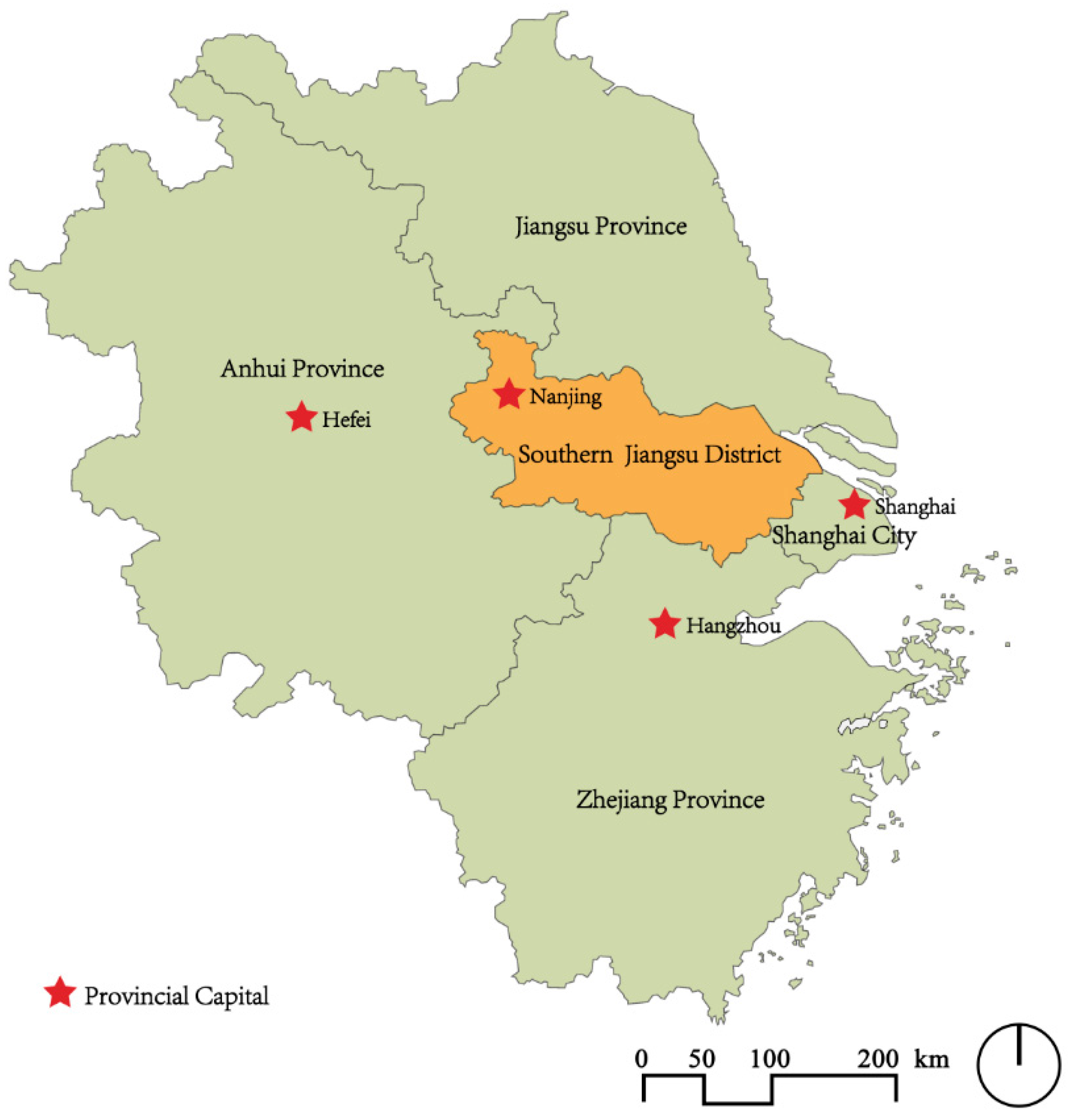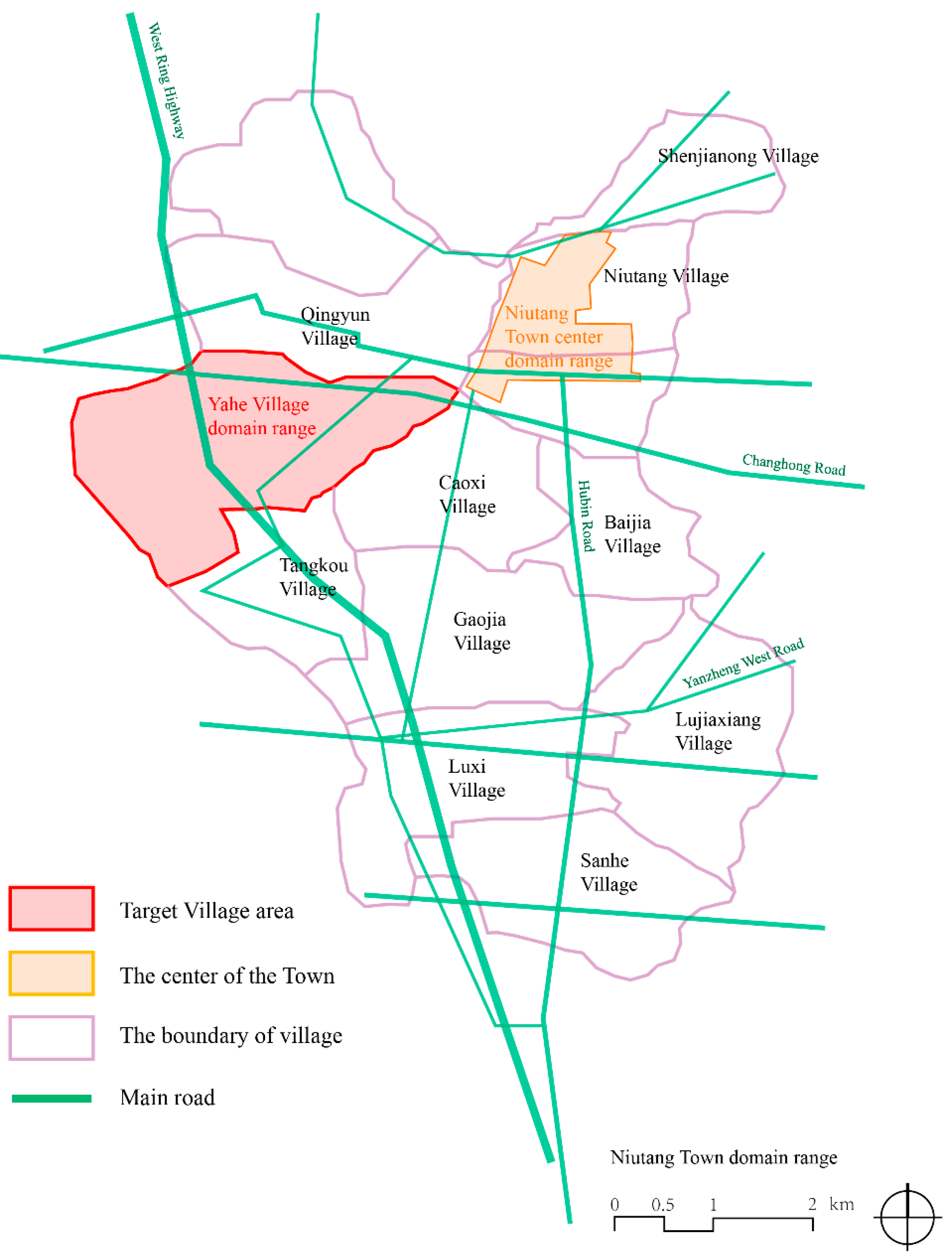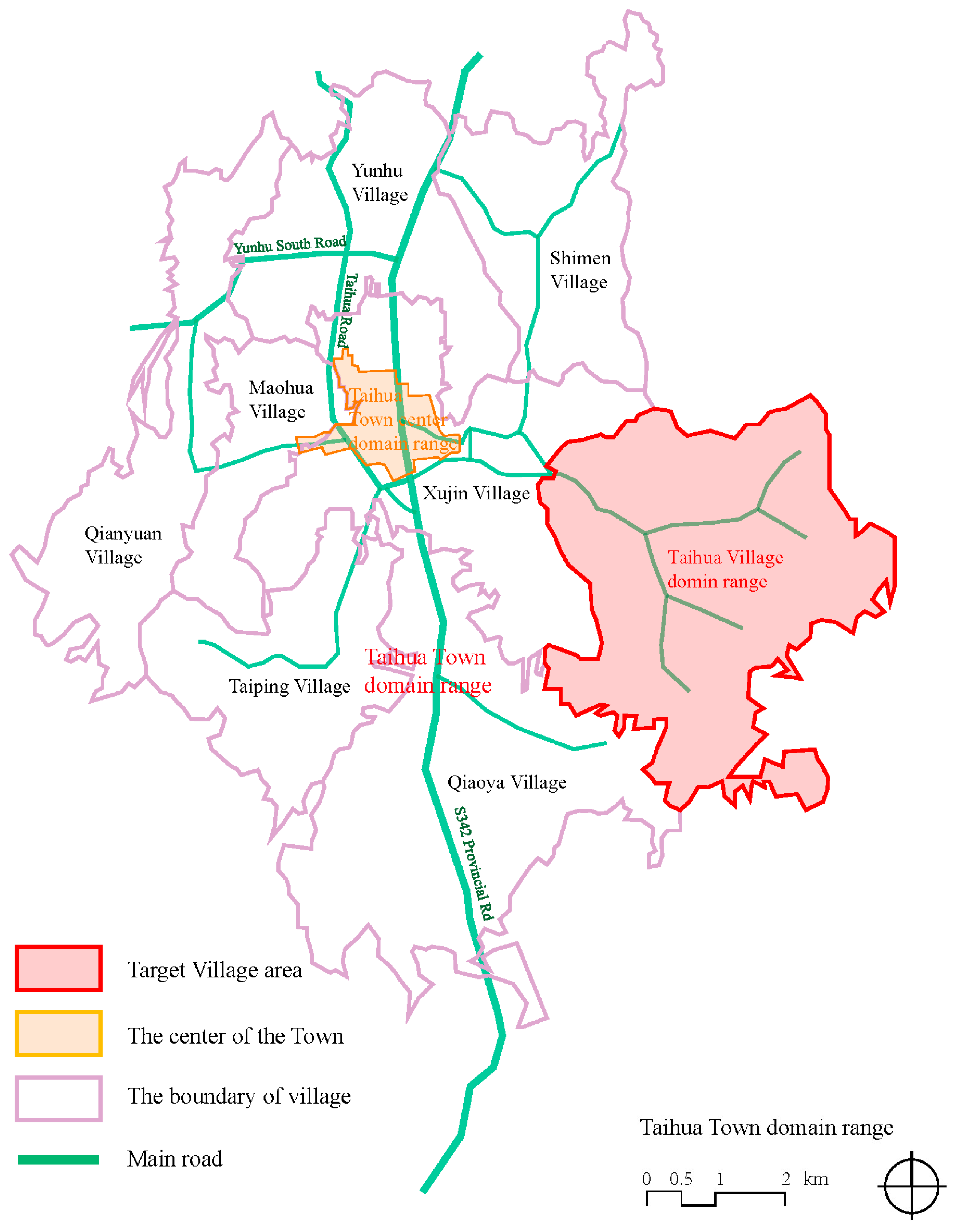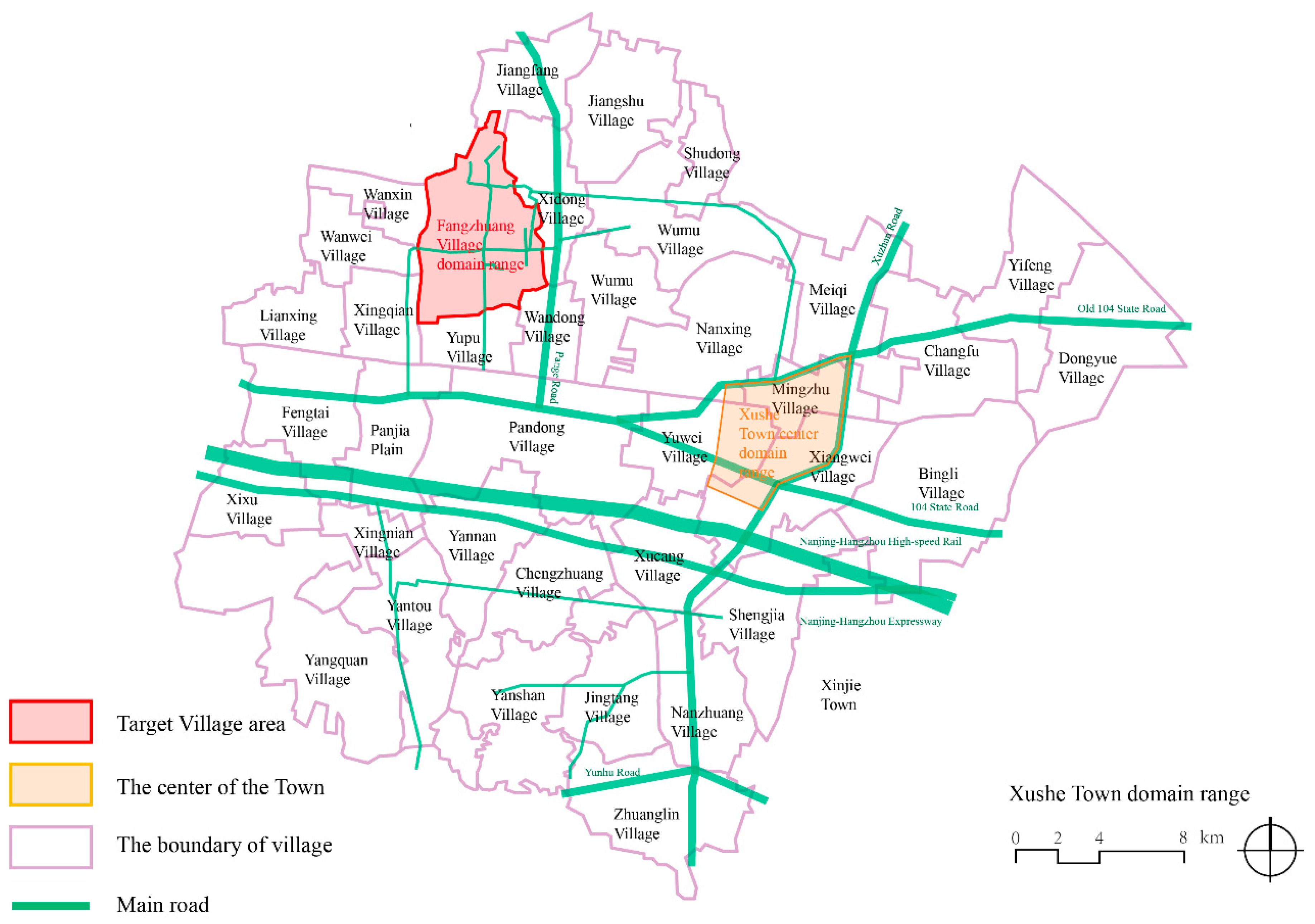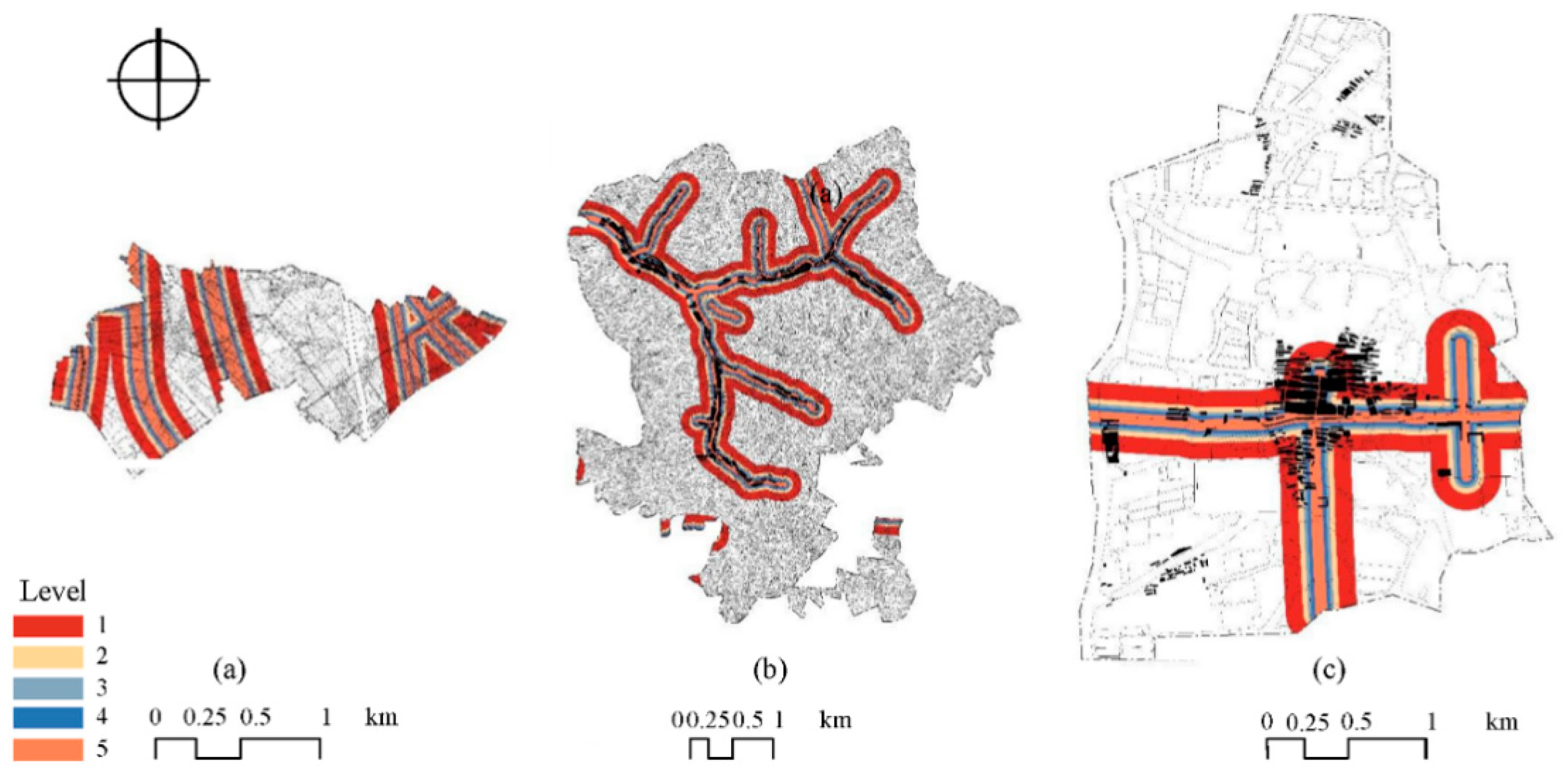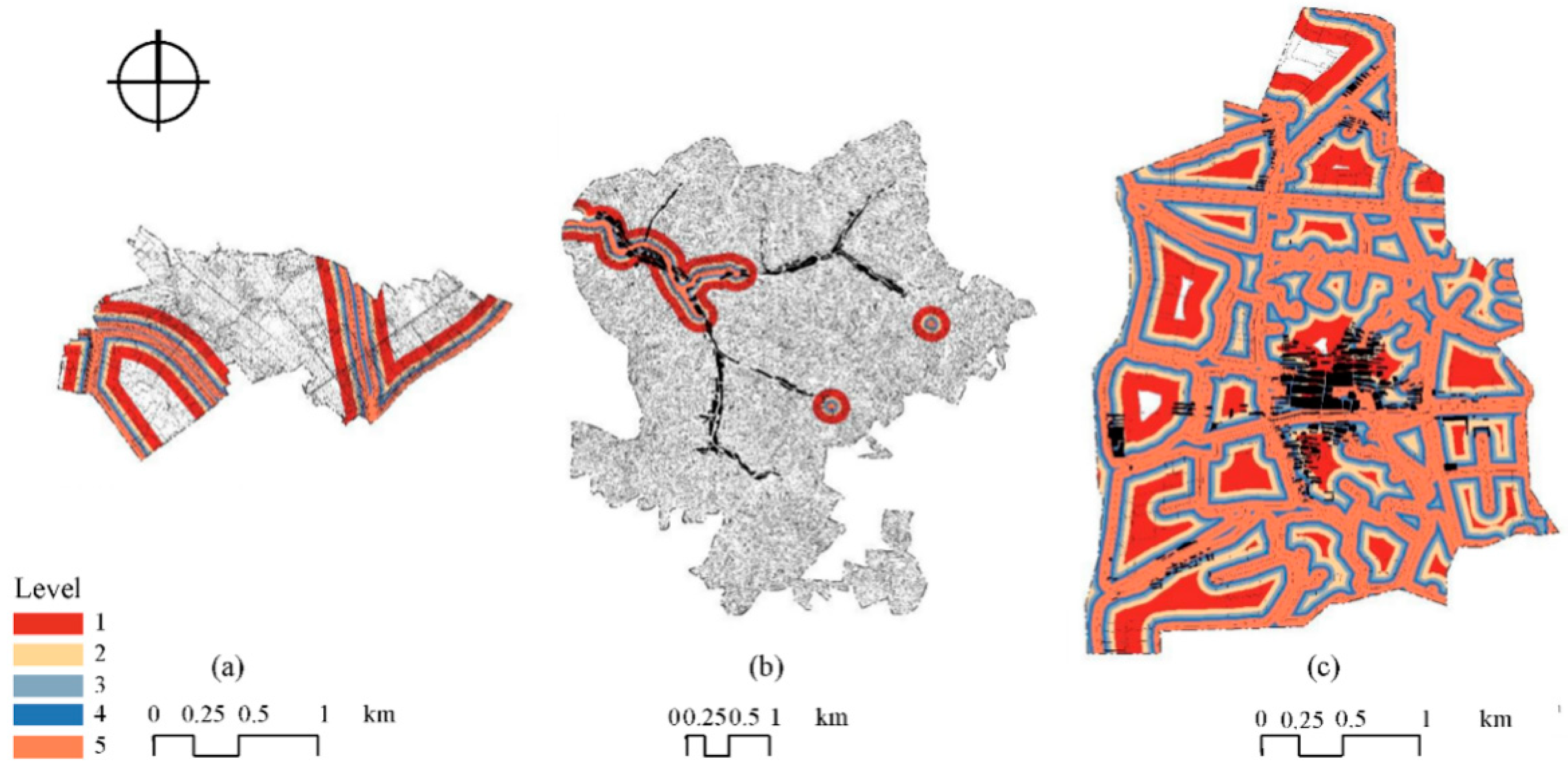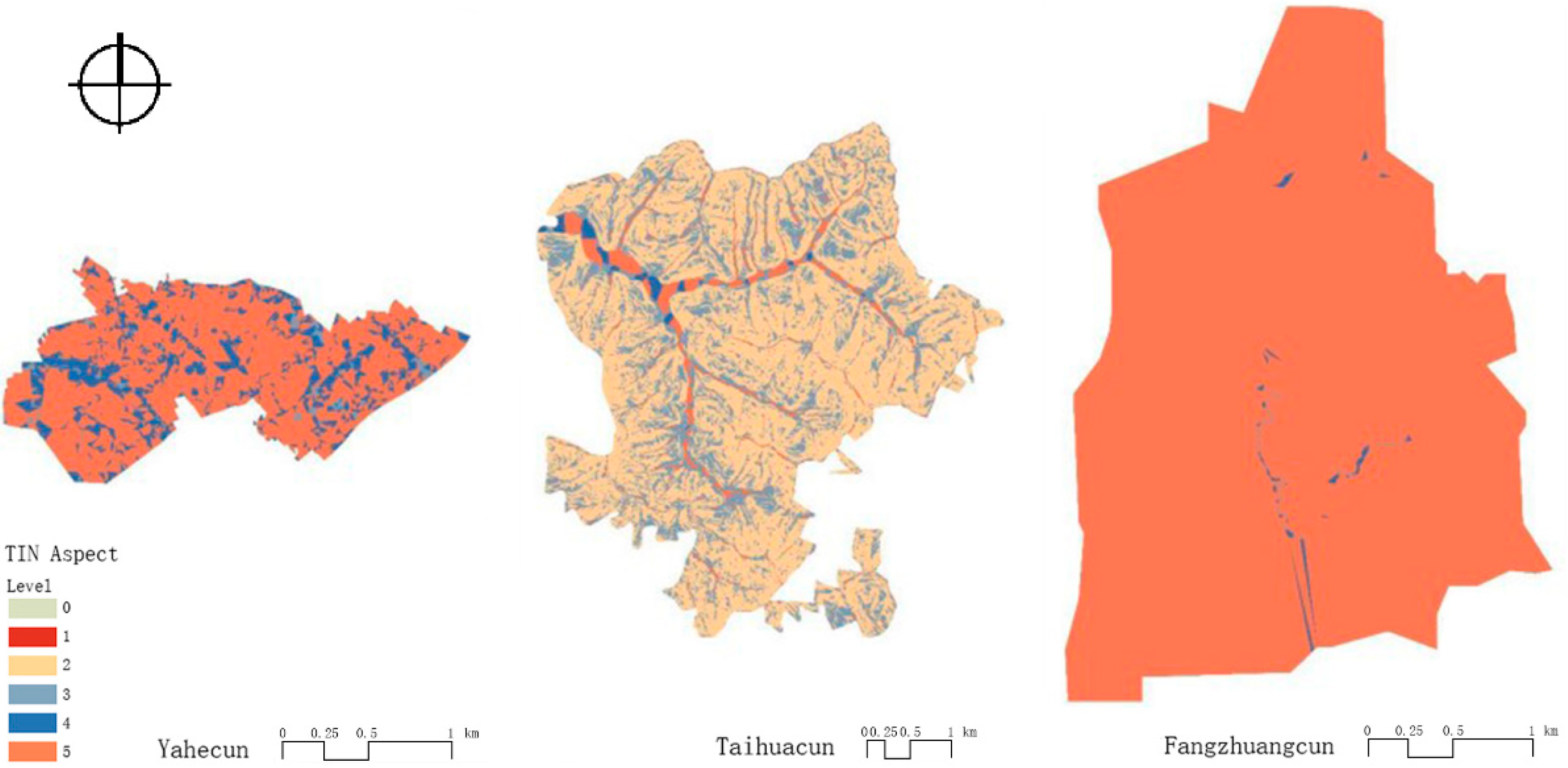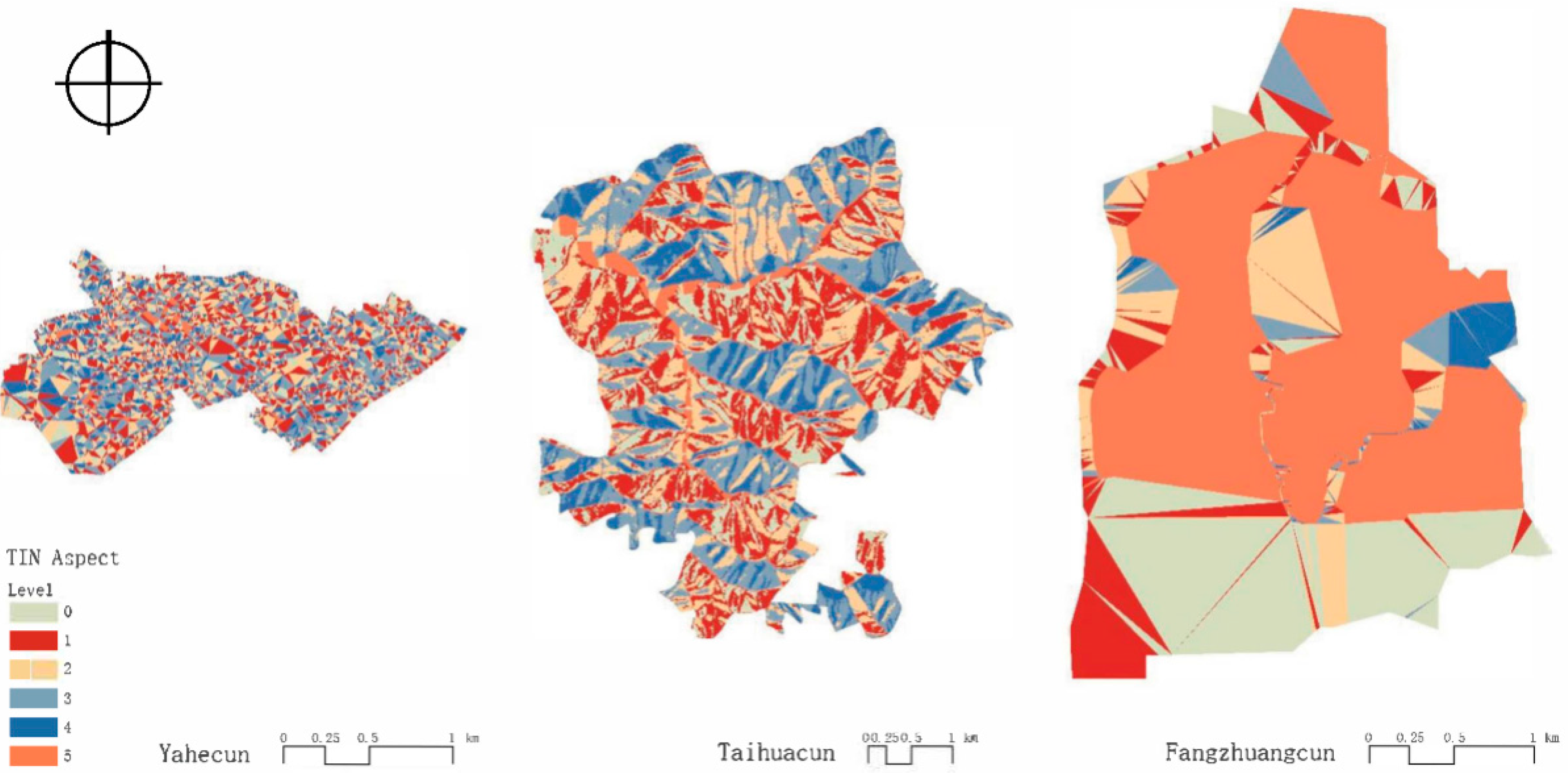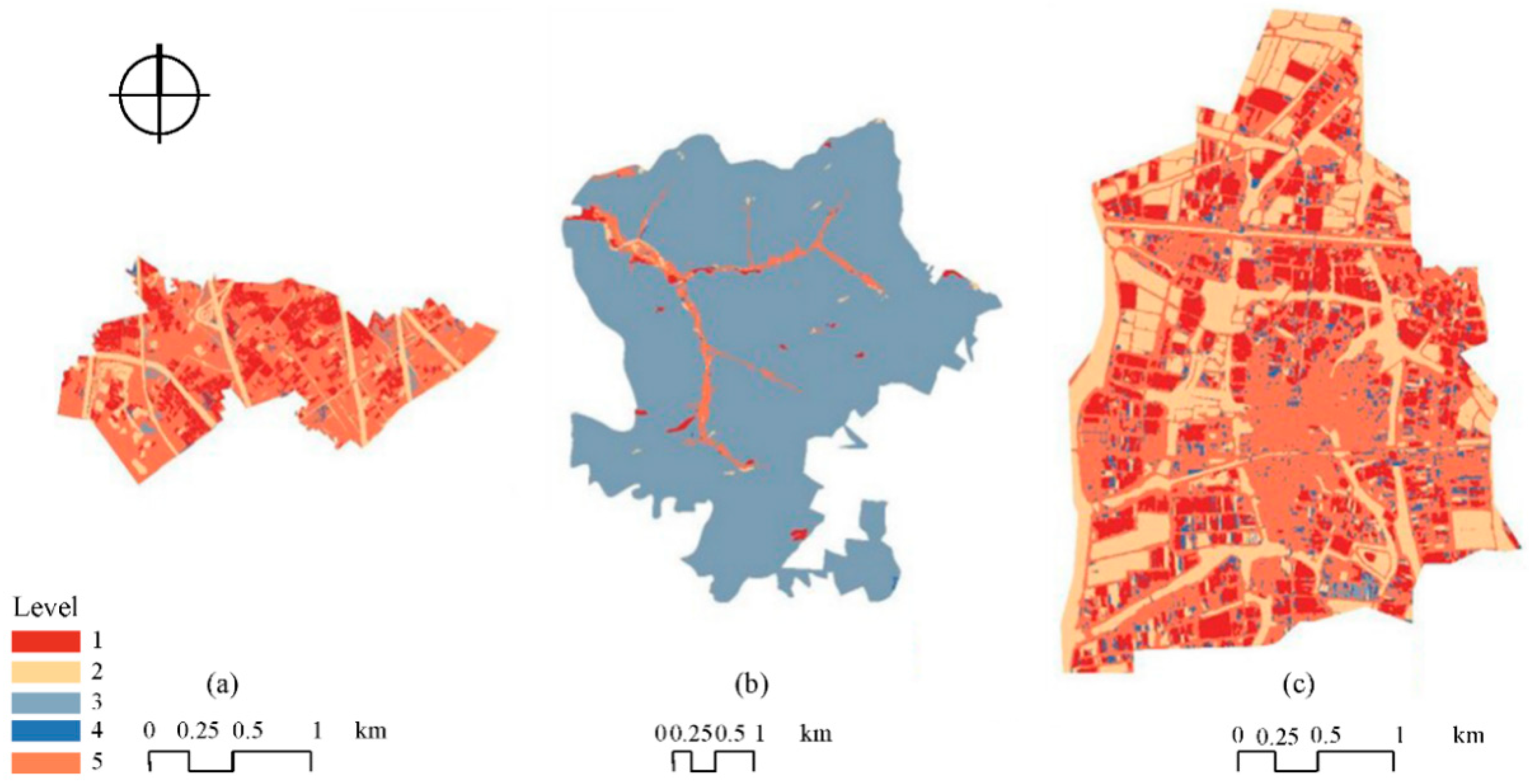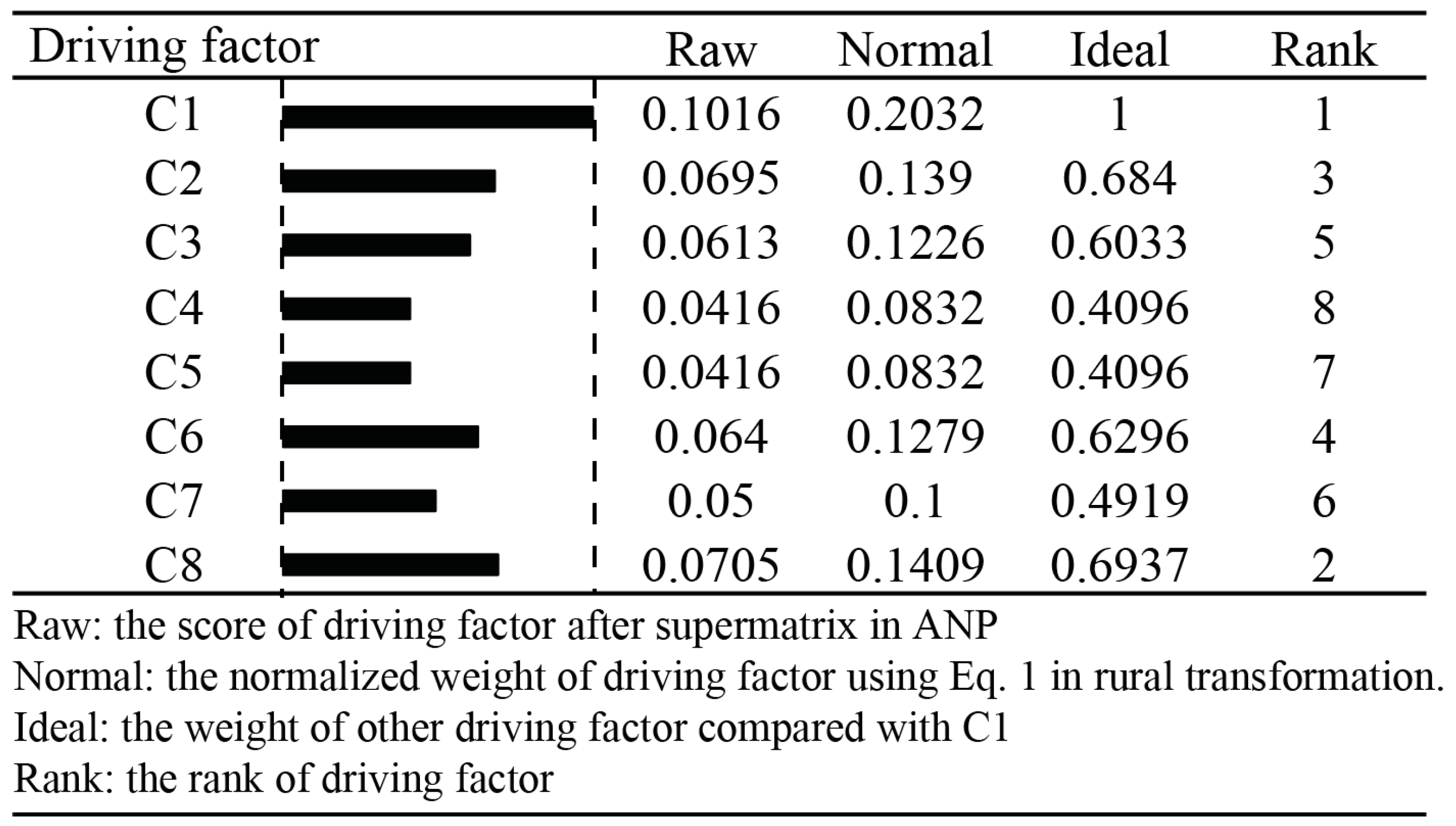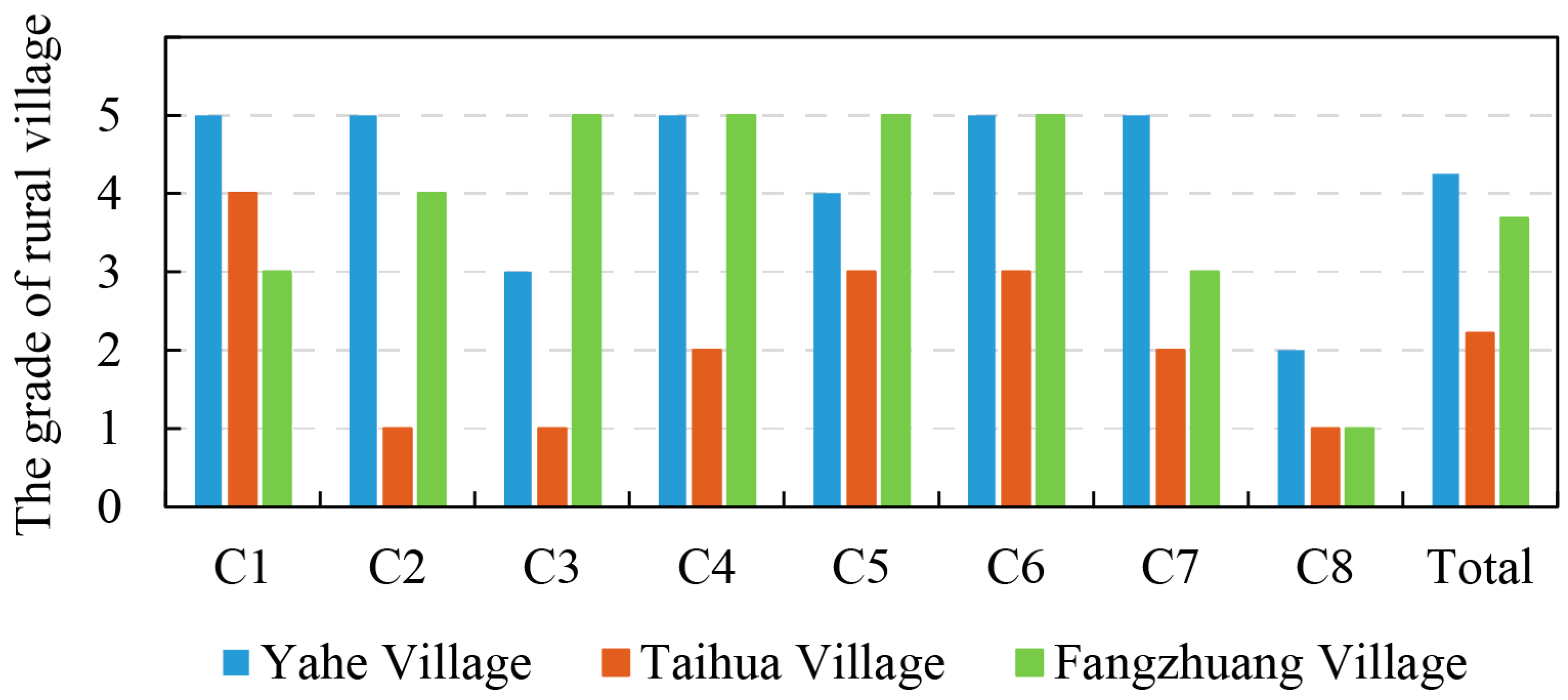1. Introduction
The rural ecosystem is a transient environment influenced by the evolution of nature and the social, economic and human activities that occur [
1]. Due to urban development, the Chinese rural population declined from 73% in the 1990s to 60% in 2005 [
2]. Despite this decline, by 2015, the Chinese rural population still accounted for 43% of the total population [
3]. With increasing economic liberalism in China, the integration of economic policies has benefitted and changed both rural and urban areas [
4]. The development has driven land-use changes [
2,
5,
6,
7] and rural-urban migration, influencing the rural spatial morphology [
2,
8]. Rural spatial morphology refers to the spatial organization amid the human-earth relationship. This considers both the tangible physical spatial form, such as geographical location, landform and the road and water systems, and the intangible social and economic form, such as village economy, culture, population, policy, etc. Combining these factors encapsulates the major driving entities that impact the evolution of rural spatial form. Moreover, an assessment of these factors can reflect the overall trend of the evolution of rural spatial form.
Historically, a single driving factor was used to assess the rural spatial morphology. For example, Lin [
9] and Yan [
10] used rural settlements to investigate aspects of natural driving forces and Guo et al. [
11] generalized the rural spatial structure of Miyun County in Beijing, to investigate artificial driving forces. However, using a single driving factor to analyze rural spatial morphology has deficiencies [
11], and therefore researchers transitioned to using multiple factors in assessments [
12,
13]. One of the earliest multi-factor studies was conducted in 1959, where Kovalev [
14] used six factors that affected the rural spatial structure, including: social economic, technological economic, the size and density of population, the relationship among village inhabitants and their spatial combination, landform and location, plane modality. Also, Evans had presented a fundamental and scientific theory introduction of urban economics in year 1985 [
15] and Skinner [
16] extensively studied the Chengdu Plain and from his research proposed the concept of “market community”, where the rural spatial structure was determined by the relationship between two factors, the transportation fee and agricultural productivity. Bedate conducted economic valuation of the cultural heritage with travel cost method in four cases studies in Spain, including a cultural artistic event, a village, a museum, and a cathedral [
17].
Despite advancements in multi-factor analysis to assess impacts on rural spatial change, consistency within the scientific community varies, with different influencing factors and different analysis techniques emphasized. Bin [
18] used quantitative analysis considering the natural environment, urban and traffic location and policy in rural villages of Guangzhou City for his assessment of rural spatial morphology. Wu [
19] suggested that the economic, social structure evolution, urbanization, change in traditional views, and the impact of national policy in different periods, combined were the major driving factors in spatial morphology. Wu [
18] suggested population be considered more fundamental or basic than an influential factor. Long et al. [
20] focused on the spatiotemporal characteristics and internal mechanisms of China’s rural areas and its effect on rural morphology. Wang et al. analyzed spatio-temporal characteristics of rural economic development in eastern coastal China, employing Gini coefficient index, Tsui-Wang index, and Theil index [
21]. Shi et al. Liu et al. [
22] administered surveys on rural land use at village scale to present how land-use change takes place in response to inhibitive institutional forces, such as lack of land ownership. Other researchers suggested migration, rural economic development, and urbanization were the primary forces driving the conversion from farmland to non-agricultural use in China [
23,
24,
25,
26]. Wang et al. applied the decoupling method for population and construction land use change in urban and rural settings and found that rural population decreased while the rural settlement land use increased, showing a strong negative decoupling [
27]. Shi et al. studies the middle basin of the Heihe River in China by considering decoupling relationship between the spatiotemporal changes in rural settlement land and rural population [
28]. Shui et al. selected a case study of China’s Xinjin county in Chengdu city to conduct the analysis of the influencing factors on farmer’s satisfaction and occupancy considering the policy of balance between urban and rural construction [
29].
In recent years, interdisciplinary, multi-variable studies have been conducted to further analyze the impact of driving factors on rural spatial morphology evolution. Within these interdisciplinary studies, some of the most common quantitative analysis methods used include: Remote Sensing (RS), Geographic Information System (GIS), and Environment for Visualizing Images (ENVI) [
30]. The study in [
31] gave a methodological framework of taking data for the popular analysis through computer tools. Murgante and Danese took the Potenza municipality in Italy as a case study to investigate spatial morphology within more than twenty-year dataset and apply some spatial statistic techniques to define suitability with indices, such as, density, distance from infrastructures, spatial autocorrelations, intensity of events and contiguity belt [
32]. Shi et al. [
33] conducted a comparative analysis of the landscape patterns of rural settlements within eight villages in Yixing City and explored the mechanism of driving factors considering landscape ecology and GIS space analysis. Wu and Wang [
34] utilized RS, GIS techniques and analytic hierarchy process (AHP) method to set up the assessment indices of landscape resources around rural-urban regions in southern Jiangsu Province, China. Zhu et al. applied a Principal Component Analysis (PCA) and Grey Entropy measurement model to evaluate urban-rural coordination by considering the indices of economic, social security, public services, and environmental quality [
35]. Liang and Peng used AHP to examine the success factors of autonomous landscape development in rural areas, covering 8 criteria and 28 sub-criteria [
36]. Using GIS, Masot and Alonso analyzed the 25 years of European rural development policy through LEADER approach to reduce the differences between rural and urban areas, as well as to satisfy the basic needs of population [
37]. Zareei [
38] evaluated biogas potential and developed a model from livestock manures and rural wastes in Iran using GIS. Cano et al. [
39] conducted a method for the inventory of traditional buildings based on a GIS in the rural development in Spain. Further, Swetnam [
40] proposed a GIS-enabled method for extensive monitoring of a valued ecosystems service in rural Wales.
Most of the rural studies with GIS and other techniques focus on the analysis of land use management or rural landscape transformation. Few assess the quantitative impact of different driving factors on rural spatial morphology evolution. To investigate the impact of different factors on rural development, this study selected three cases of typical rural villages in southern Jiangsu Province, China, and selected eight driving factors in terms of the location, landform, and social economy, to analyze the spatial form of rural villages. The eight driving factors were explored in three rural village spatial morphologies and ArcGIS and ENVI were utilized for the quantitative analysis. Hypothetically, there are certain intrinsic relevance between the quantized grades of these driving factors and evolution trends of these villages. Finally, the Analytic Network Process (ANP) decision-making method was applied to provide a quantitative assessment of different types of rural villages. This study aims to achieve the following objectives:
- (1)
Apply eight driving factors to analyze the rural spatial morphology of three typical rural villages in a case study.
- (2)
Propose a novel framework for quantifying the impact of the eight driving factors on rural spatial morphology based on ArcGIS, ENVI, and ANP.
- (3)
Provide a baseline to help assess the decision making of development of different types of rural villages using the driving factors.
- (4)
Finally, provide predictive and analytical insights into the typical rural spatial morphology evolution trend.
3. Case Study
Figure 4 shows the logic of the proposed framework in this study, and to validate the framework, this study selects three typical villages as a case study. Three cases of rural villages, located in the south of Jiangsu Province, were selected to assess the rural transformation. The southern Jiangsu Province is one of the most economically-developed regions in Jiangsu Province and China, shown in
Figure 5. The region is a good representation of a typical case found in Chinese rural spatial morphology evolution. This study selected three different types of rural villages within the southern Jiangsu Province, namely, a suburb-radiation type, a resource-development type, and an integrated and independent type.
Data used included Yearbook reports provided by local governments, topographic information, coupled with Google map imagery. Specifically, geographical information, including AutoCAD maps and high-definition satellite imaging maps in different periods of the villages, were obtained from governmental departments. In addition, it was generally assumed that the topographic and mapping information was accurate, therefore, the emphasis of this paper is on completing the research objectives of defining a novel framework for quantifying the impact of the eight driving factors on rural spatial morphology based on ArcGIS, ENVI, and ANP and applying this to the case study, and providing a baseline to help assess decision making.
However, in addition to the data collection, informal site observations, recording and video shooting, and visits to the relevant administrative departments, were conducted as part of the data collection process. However, these trips were mainly used to provide a more complete assessment of the data, with the raw content not included in this paper.
3.1. Villages of Suburb-Radiation Type
Villages of suburb-radiation type are located near the nucleus of the town development and have a prominent location advantage. The convenient traffic, economic advantage, and job opportunity of the town can attract inhabitant migration from rural villages in search of improved economic opportunity. This negatively impacts the rural infrastructure and strength. Therefore, villages of suburb-radiation type assume a pro-economic development trend and toward densification.
Yahe Village is of suburb-radiation type and located by Niutang Town, the epicenter of the Wujin District of Changzhou City, shown in orange in
Figure 6. Yahe Village has an area of 3.6 km
2 with 3215 official villagers and roughly 2500 inhabitants from other areas. In 2016, the annual per-capita net income was roughly RMB 26,800. The distance to Niutang Town is about 3.5 km by bus taking about 27 min. Driving a car the distance and time shortens to 3 km and 7 min.
3.2. Villages of Resource-Development Type
The villages of the resource-development type have unique resource and industrial advantages and limitations, providing more consistent morphology overtime. Generally, such areas have limited natural and industrial activities, only enough to promote self-supporting rural developments, rather than mighty or emerging industries, such as newly-discovered mineral resources, scientific and technological support. Therefore, the rural area is basically stable, with new construction activities limited to mostly upgrading or re-constructing original dwellings. The vitality, vigor and traditional landscape of the village can be maintained over time.
Taihua Village is located by Taihua Town, the center of which is orange (
Figure 7), and includes the famous Taihua Mountains. It has an area of 18 km
2. Taihua region has the largest moso bamboo base in Jiangsu province, with bamboo forest covering about 7 km
2. Considering its unique natural landscape, limited technological resources and moso bamboo processing industry, Taihua Village can be categorized as a village of resource-development type.
3.3. Villages of Integrated and Independent Type
Villages of integrated and independent type are furthest away from the town, located beyond the radiation of town resources, and often require superior resource endowments to support their development. Villages of this type are often combined with traditional villages or towns, and have little to no new development.
Located in the northwest of Xushe Town, the center of which is orange in
Figure 8, Fangzhuang Village has an area of 7 km
2 with annual per-capita income of RMB 11,678. Fangzhuang Village is the furthest away from the town, and does not have a large-scale township, but its unique history, humanistic landscape and distinctive local industry (e.g., mutton), enable the village to maintain some development.
5. Discussion and Limitations
The sustainability of rural development is quite important in modernizing the agricultural and forestry sectors, protecting the environment and improving the quality of life [
43]. China has hundreds of thousands of rural villages, which occupy more than half of all Chinese land (about 58%). Although China has a unique urban-rural relation, the development of rural villages always lies in a relatively disadvantageous position, impacting relevant data reserves. In the context of information technology, interdisciplinary research has been arousing more and more attention, further expanding technical and methodologic capabilities. This study quantitatively obtained the grade distribution diagram within the case study of three typical villages. Eight driving factors of three rural villages, in terms of geographical location, landform, and social economy of rural villages were obtained and accordingly conducted quantitative research on three rural villages with ArcGIS and ENVI. A decision-making method, ANP, was utilized to analyze the performance of different driving factors in rural spatial morphology evolution of the villages. The objective of this study was to investigate the correspondence between the rural spatial morphology through quantitative analysis and compare the performance of different village types. The techniques and methodology established in this study provide a baseline for future studies and can be used in influence policy makers. In the context of China’s new urbanization, this study can compensate for the insufficiency of present study countryside. This study can be regarded as a kind of positive and beneficial exploration by extending the knowledge of ArcGIS spatial structure and ANP integrated multi-criteria decision-making process to quantitatively analyze and evaluate rural area. To summarize the results, this study suggests:
- (1)
The village of suburb radiation type is a rural mode in the effective radiation scope of the town, and the quantification to rural spatial structure indicates that it has a great development potential. The evolution trend of rural villages of this type usually performs as a growth type, indicating that most of the villages which are close to the urban system, having a strong potential of development and vitality;
- (2)
The village of resource development type is supported by characteristic industries, and the quantification to rural spatial structure, indicating certain developmental advantages. The trend of spatial form of villages of this type generally assumes a development mode of progression, and can maintain its own steady development under the support of supportive industries, and can moderately receive certain policy support;
- (3)
Villages of integrated and independent type do not have the same location advantage and industrial advantage as the above two types of villages. Most of them are based on the combination of several aggregated natural villages retained for the historical reason. The results from the quantification of this type indicate that: (a) social and economic forms show an obvious growth; and (b) material space forms show some stability. Any popularity in new rural growth maybe temporary and if not supported, becomes unsustainable. Considering the low grade calculated in the results, suitable economic or industrial recurrent support to maintain continuous and steady development of villages of this type is needed.
Despite the clear findings, there were some limitations when conducting this study. Firstly, the difficulty in obtaining historical data and the rapid development of Chinese urbanization makes it difficult for the diachronic evolution of spatial forms of rural villages. A longer period of data is required for more comprehensive studies of rural villages. Secondly, based on the Chinese household management system, the rural people who work and live for a long time in cities but whose household registration has not been transferred out of rural villages are still categorized in rural population. As a result, the population density generated according to the statements is on the high side, and cannot fully reflect the actual population density of rural villages. Meanwhile, due to the lack of net income of individual families, this study did not visualize spatially the information of factors c7 and c8. However, it is important to conduct such spatialized information in the future with a more detailed dataset. Additionally, indices could be included in future studies to research historical space forms of rural villages. Finally, although ArcGIS has obvious technical advantages in spatial data analysis, however, rural studies are more complex and if data collection and arrangement is lacking regarding to rural planning and construction, it becomes difficult to timely and effectively collect, arrange and renew the data based on the analysis of the ArcGIS analysis, e.g., income, population and digital elevation.
